 W
WThe Ford Pinto is a subcompact car that was manufactured and marketed by Ford Motor Company in North America from the 1971 to the 1980 model years. The Pinto was the first subcompact vehicle produced by Ford in North America.
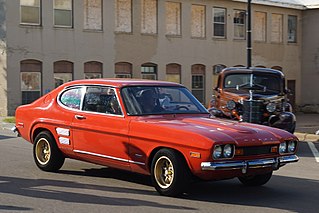 W
WCapri is a nameplate marketed by the Lincoln-Mercury division of Ford Motor Company on three distinct series of automobiles between 1970 and 1994. From 1970 to 1978, the Capri was a sport compact marketed without any Ford divisional branding, sourced as a captive import from Ford of Europe. From 1979 to 1986, the Capri became part of the Mercury model line as a pony car. From 1991 to 1994, the Mercury Capri was a roadster, sourced as a captive import by Ford of Australia.
 W
WThe Mercury Colony Park is a full-size station wagon that was marketed by the Mercury division of Ford Motor Company between 1957 and 1991. Distinguished by its simulated wood-grain paneling, the Colony Park was marketed as either the premium-trim or the sole full-size station wagon offering of the division. Following the demise of Edsel, full-size Mercury and Ford vehicles adopted similar bodyshells, with the Colony Park becoming the counterpart of the Ford Country Squire until their discontinuation.
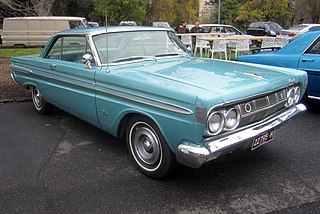 W
WThe Mercury Comet is an automobile that was produced by Mercury from 1960–1969 and 1971–1977 — variously as either a compact or an intermediate car. In its first two years, it was marketed as the "Comet" and from 1962 as the "Mercury Comet".
 W
WThe Mercury Commuter is a full-size station wagon that was produced by Mercury from 1957 to 1968. When introduced for the 1957 model year it was priced below Mercury's other two new full size wagons, the Voyager and the Colony Park. In 1957 the same 368 cu in (6.0 L) Lincoln Y-Block V8 that was standard equipment on the Mercury Turnpike Cruiser was optional equipment on the Commuter.
 W
WMercury Cougar is a nameplate applied to a diverse series of automobiles sold by the Mercury division of Ford from 1967 to 1997 and from 1999 to 2002. While the nameplate is most commonly associated with two-door coupes, at various times during its production, the Cougar was also marketed as a convertible, four-door sedan, station wagon, and hatchback.
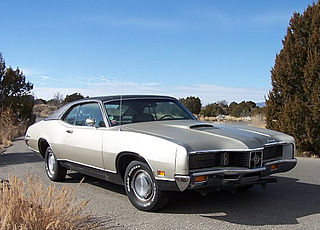 W
WThe Mercury Cyclone is an automobile that was marketed by the Mercury division of Ford from 1964 to 1971. Introduced in 1964 as the Mercury Comet Cyclone, the Cyclone replaced the S-22 as the performance-oriented version of the Mercury Comet model line. The Cyclone became a distinct nameplate for the 1968 model year, as the Mercury Montego was phased in to replace the Comet.
 W
WThe Mercury Cyclone Spoiler II is a muscle car that was produced by Mercury in early 1969. The Mercury Cyclone Spoiler II was a special, more aerodynamic version of the Mercury Cyclone. It was produced specifically to make Mercury even more competitive in NASCAR stock car racing, and was sold to the public only because homologation rules required a minimum number of cars be produced and made available for sale to the public. All production examples were constructed during the first few weeks of 1969.
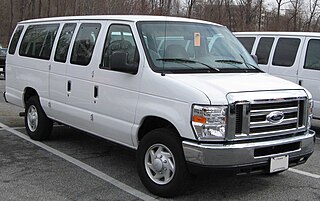 W
WThe Ford E-Series is a range of full-size vans produced by American automaker Ford. Introduced for the 1961 model year as the replacement for the Ford F-series panel van, the model line is currently in its fourth generation.
 W
WThe Mercury Eight is an automobile that was marketed by the Mercury division of Ford between 1939 and 1951. The debut model line of the Mercury division, Ford slotted the full-size Mercury Eight between the Ford Deluxe model lines and the Lincoln. In total, Ford assembled three generations of the Eight.
 W
WThe Mercury Grand Marquis is an automobile that was sold by the Mercury division of Ford Motor Company from 1975 to 2011. From 1975 to 1982, it was the premium model of the Mercury Marquis line of full-size sedans, becoming a standalone model line in 1983. For 2003 and 2004, it was sold alongside the revival of the Mercury Marauder.
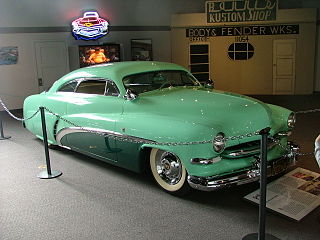 W
WThe Hirohata Merc is a 1950s custom car, often called "the most famous custom of the classic era". Setting a style and an attitude, it had a "momentous effect" on custom car builders, appeared in several magazines at the time and has reappeared numerous times since, earning an honorable mention on Rod & Custom's "Twenty Best of All Time" list in 1991. The impact may be measured by the fact that, after more than fifty years and numerous owners, it is still known as "the Hirohata Merc".
 W
WThe Ford EXP is a sports compact coupe that was produced and sold by Ford Motor Company in North America from the 1982 to 1988 model years. The first two-seat Ford since the 1957 Thunderbird, the EXP made its debut at the 1981 Chicago Auto Show. Sharing the dashboard, wheelbase, suspension, and powertrain with the Ford Escort, the EXP was longer, lower, and more aerodynamic than its five-seat counterpart.
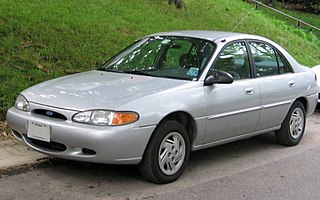 W
WThe North American variant of the Ford Escort is a compact/small family car introduced by Ford in 1980 for the 1981 model year. Sharing its name with the third-generation European Ford Escort, the model line is the first front-wheel drive Ford developed and sold in North America. The direct successor of the Ford Pinto, as the smallest Ford car in North America, the Escort largely replaced the European-imported Ford Fiesta.
 W
WThe Mercury M series is a series of pickup trucks that was marketed by the Mercury division of Ford Motor Company. Produced from 1946 to 1968, the Mercury M series was sold primarily in Canada, as a rebadged version of the Ford F series.
 W
WThe Mercury Marauder is an automobile nameplate that was used by three distinct full-size cars produced by the Mercury division of Ford Motor Company. Deriving its name from the most powerful engines available to the Mercury line, the Marauder was marketed as the highest-performance version of the full-size product range.
 W
WThe Mercury Mariner is a compact crossover SUV that was introduced in 2005. It is a sibling of the Mazda Tribute and Ford Escape, although it is more upmarket than the other two. The Mariner is Mercury's first car-based SUV, and is slotted below the Mountaineer in the lineup. When Ford eliminated the Mercury brand, the Mariner ended production in October 2010.
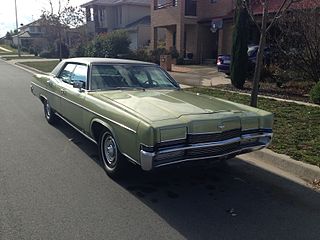 W
WThe Mercury Marquis is a model line of automobiles that was marketed by the Mercury division of Ford Motor Company. Deriving its name from a French nobility title, the Marquis was sold across four generations from 1967 to 1986; through its entire production, the model line was the Mercury divisional counterpart of the Ford LTD. Initially introduced as the flagship Mercury range, the Marquis line was later expanded to include the Mercury Grand Marquis slotted above it.
 W
WThe Mercury Messenger is a concept car that was created by Mercury in 2003. It was revealed at the North American International Auto Show in Detroit that year. The vehicle was named after Mercury, the Roman messenger god from whom Mercury gets its name.
 W
WThe Mercury Meteor is an automobile that was produced by Mercury from 1961 to 1963. For 1961, the name was applied to low-end full-sized vehicles; for 1962 and 1963, the name was applied to Mercury's mid-sized sedans, in a marketing attempt to appeal to the excitement surrounding the Space Race, before being discontinued. Introduced while Mercury as a marque was in flux, and never a solid marketplace performer in consumer sales, the Meteor remains more a side note than a well known Mercury product.
 W
WThe Mercury Milan is a mid-size car that was marketed by the Mercury division of Ford Motor Company. Named after Milan, an Italian city, the Milan was sold across the 2006 to 2011 model years across a single generation. The smaller of two model lines developed to replace the Mercury Sable, indirectly succeeding the Mercury Mystique as the smallest Mercury sedan.
 W
WThe Mercury Monarch is a compact automobile that was marketed by the Mercury division of Ford from the 1975 to 1980 model years. Designed as the original successor for the Mercury Comet, the Monarch was marketed as a luxury compact vehicle; alongside its Ford Granada counterpart, the Monarch expanded the segment in the United States as automakers responded to the 1973 fuel crisis.
 W
WThe Mercury Montclair is a series of full-size sedans that were manufactured and marketed by the Mercury division of Ford. The nameplate was used by the division twice, from the 1955 to the 1960 model years and from the 1964 to the 1968 model years. While not offered as a station wagon, the Montclair was offered as two-door and four-door hardtops, four-door pillared sedan, and a two-door convertible.
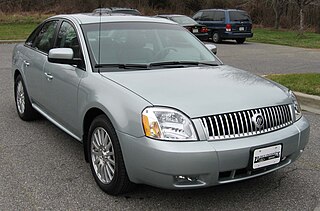 W
WThe Mercury Montego is a nameplate that was applied to three separate generations of vehicles marketed by the Mercury division of Ford Motor Company. Taking its name from Montego Bay, Jamaica, the nameplate made its first appearance for 1967 in the Canadian market as part of the Mercury-derived Meteor model line. For 1968, the Mercury Montego made its debut across North America, becoming the Mercury counterpart of the Ford Torino intermediate-size model line for two generations.
 W
WThe Mercury Monterey is a series of full-size cars that were manufactured and marketed by the Mercury division of Ford from 1952 to 1974. Deriving its name from Monterey Bay, the Mercury Monterey served as the replacement for the Mercury Eight, the debut model line of the Mercury division. During its production, the Monterey would be offered in multiple body styles, ranging from coupes, convertibles, sedans, hardtops, and station wagons.
 W
WThe Mercury Mountaineer is a mid-size luxury sport utility vehicle (SUV) that was sold by Mercury from 1996 until 2010. Sharing many of its features with the Ford Explorer, the vehicles were virtually identical in terms of hardware. Externally, they were styled somewhat differently, and the Mountaineer was positioned with a more upscale interior, with the Mountaineer's MSRP coming in at $1,000–$6,000 more than the Explorer. It was last redesigned for the 2006 model year with a new frame, looking very similar to its previous model.
 W
WThe Ford Mondeo I is a mid-size car that was produced by Ford, beginning on 23 November 1992, with sales beginning on 22 March 1993. It is also known as the Mk I Mondeo; the 1996 facelift versions are usually designated Mk II. Available as a four-door saloon, a five-door hatchback, and a five-door estate, all models for the European market were produced at Ford's plant in the Belgian city of Genk. In December 1992, Autocar published a section on the Mondeo, and how it would conquer rivals.
 W
WThe Mercury Park Lane is a full-sized automobile that was produced by the Mercury division of Ford Motor Company. While not officially introduced as the replacement of the Mercury Turnpike Cruiser, the Park Lane became the flagship of the Mercury model line upon its introduction. The second-generation Park Lane was positioned above the Mercury Montclair.
 W
WThe Mercury S-55 is a full-size car that was marketed by the Mercury division of the Ford Motor Company during the 1960s. Developed as a performance-oriented version of the Mercury Monterey, the S-55 was the largest vehicle of the Mercury "S" (Special) range introduced in 1962; its Ford equivalent was the Ford Galaxie 500XL.
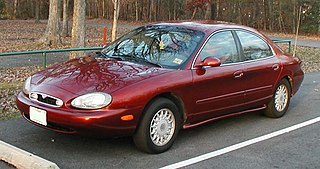 W
WThe Mercury Sable is a range of automobiles that were manufactured and marketed by the Mercury brand of Ford Motor Company. Introduced on December 26, 1985, as the replacement for the Mercury Marquis, the Sable marked the transition of the mid-size Mercury product range to front-wheel drive.
 W
WThe Ford Tempo and its twin, the Mercury Topaz, are compact cars that were produced by the Ford Motor Company for model years 1984 to 1994. They were downsized successors to the boxy Ford Fairmont and Mercury Zephyr twins. The Tempo and Topaz were part of a rejuvenation plan by Ford to offer more environmentally friendly, fuel efficient, and more modern styled models to compete with the European and Japanese imports. While the car sold well, its innovation and aerodynamic design paved the way for the even more groundbreaking Ford Taurus. The Tempo and Topaz were replaced for 1995 by the "world car" platform sold in North America as the Ford Contour and Mercury Mystique.
 W
WThe Mercury Tracer is an automobile that was marketed by Mercury from the 1987 through 1999 model years. The successor to the Mercury Lynx, the Tracer also served as the smallest vehicle line sold by the Lincoln-Mercury division. Throughout its production, the Tracer was marketed as a hatchback, four-door sedan, and five-door station wagon.
 W
WThe Mercury Turnpike Cruiser is a series of automobiles that were produced by the Mercury division of Ford for the 1957 and 1958 model years. Named to commemorate the creation of the Interstate Highway System, the Turnpike Cruiser was marketed as the flagship Mercury model line, slotted above the Montclair.
 W
WThe Mercury Villager is a minivan that was marketed by the Mercury division of Ford. The first of two minivans sold by Mercury, two generations were sold from the 1993 to 2002 model years. Competing against the Chrysler minivans and the General Motors APV minivans, the front-wheel drive Villager was introduced between the Ford Aerostar and the Ford Windstar.
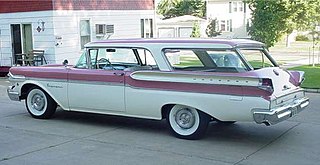 W
WThe Mercury Voyager is a station wagon that was sold by the Mercury division of Ford for the 1957 and 1958 model years. For the 1957 model year, Mercury created a model range of station wagons distinct from sedans, following Ford. The Voyager served as the mid-range offering, slotted above the base-trim Mercury Commuter, with the woodgrained Colony Park serving as the top-range offering.
 W
WThe Mercury XM-800 is a concept car created by Mercury and first introduced at the 1954 Chicago Auto Show. In newspaper publicity at its 1954 debut, in Chicago and elsewhere, it was presented with its full name, Mercury Monterey XM-800. The XM, or experimental Mercury, "push car" went the 1954 US auto show circuit season. Although it was promoted by Ford as an "advanced design, engineered to go into volume production,” the XM 800 never passed the concept phase.
 W
WThe Ford Fairmont is a compact car that was produced by Ford from the 1978 to the 1983 model years. The successor of the Ford Maverick, the Fairmont was the third generation of compact sedans sold by Ford in North America; Lincoln-Mercury marketed the model line as the Mercury Zephyr. In contrast to the Maverick, the Fairmont was a completely new design, no longer based upon the Ford Falcon.